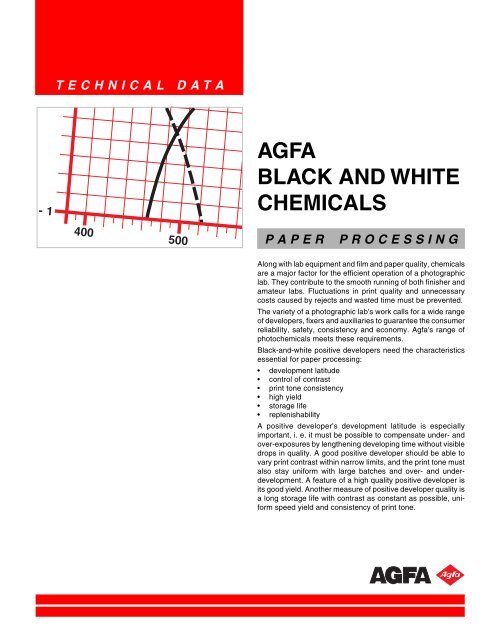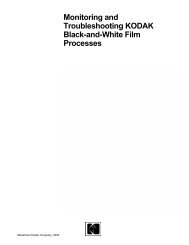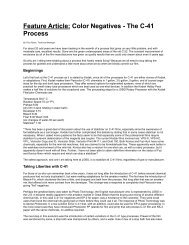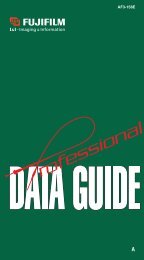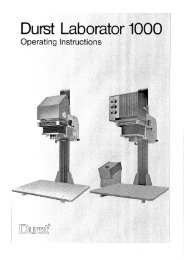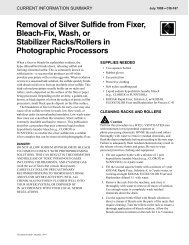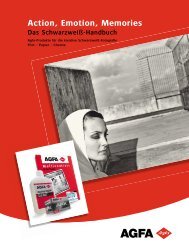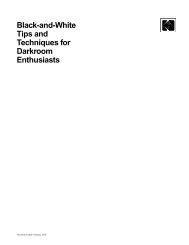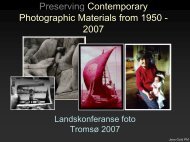AGFA BLACK AND WHITE CHEMICALS - Maug Lee
AGFA BLACK AND WHITE CHEMICALS - Maug Lee
AGFA BLACK AND WHITE CHEMICALS - Maug Lee
You also want an ePaper? Increase the reach of your titles
YUMPU automatically turns print PDFs into web optimized ePapers that Google loves.
T E C H N I C A L D A T A<br />
- 1<br />
<strong>AGFA</strong><br />
<strong>BLACK</strong> <strong>AND</strong> <strong>WHITE</strong><br />
<strong>CHEMICALS</strong><br />
400 500<br />
P A P E R<br />
P R O C E S S I N G<br />
Along with lab equipment and film and paper quality, chemicals<br />
are a major factor for the efficient operation of a photographic<br />
lab. They contribute to the smooth running of both finisher and<br />
amateur labs. Fluctuations in print quality and unnecessary<br />
costs caused by rejects and wasted time must be prevented.<br />
The variety of a photographic lab's work calls for a wide range<br />
of developers, fixers and auxiliaries to guarantee the consumer<br />
reliability, safety, consistency and economy. Agfa's range of<br />
photochemicals meets these requirements.<br />
Black-and-white positive developers need the characteristics<br />
essential for paper processing:<br />
• development latitude<br />
• control of contrast<br />
• print tone consistency<br />
• high yield<br />
• storage life<br />
• replenishability<br />
A positive developer's development latitude is especially<br />
important, i. e. it must be possible to compensate under- and<br />
over-exposures by lengthening developing time without visible<br />
drops in quality. A good positive developer should be able to<br />
vary print contrast within narrow limits, and the print tone must<br />
also stay uniform with large batches and over- and underdevelopment.<br />
A feature of a high quality positive developer is<br />
its good yield. Another measure of positive developer quality is<br />
a long storage life with contrast as constant as possible, uniform<br />
speed yield and consistency of print tone.<br />
1
Index<br />
Page<br />
1. Storage, safety at work, handling the photochemicals ............................................... 3<br />
2. Short product description.............................................................................................. 3<br />
3. Print tone ......................................................................................................................... 4<br />
4. Use of the developer liquid concentrates .................................................................... 4<br />
4.1 MULTICONTRAST DEVELOPER ................................................................................................................ 4<br />
4.2 NEUTOL plus ............................................................................................................................................... 5<br />
4.3 NEUTOL plus / LOR ..................................................................................................................................... 5<br />
4.4 NEUTOL, NEUTOL LIQUID NE, NEUTOL LIQUID WA ............................................................................... 5<br />
4.5 AGETOL LIQUID .......................................................................................................................................... 6<br />
5. Use of the powder developers....................................................................................... 7<br />
5.1 NEUTOL NE and WA ................................................................................................................................... 7<br />
5.2 METINOL ..................................................................................................................................................... 7<br />
5.3 ADAPTOL .................................................................................................................................................... 8<br />
6. Stop bath (interrupter).................................................................................................... 8<br />
7. Use of the fixers .............................................................................................................. 8<br />
7.1 AGEFIX ........................................................................................................................................................ 8<br />
7.2 MC FIXER .................................................................................................................................................... 9<br />
7.3 ACIDOFIX .................................................................................................................................................... 9<br />
7.4 Fixer monitoring ........................................................................................................................................... 9<br />
7.5 Silver recovery ............................................................................................................................................. 9<br />
7.6 Fixer recycling .............................................................................................................................................. 9<br />
8. Soda interim bath .......................................................................................................... 10<br />
9. Final wash ...................................................................................................................... 10<br />
10. Use of the auxiliaries ..................................................................................................... 10<br />
10.1 AGEPON ..................................................................................................................................................... 10<br />
10.2 ALGEZID II .................................................................................................................................................. 10<br />
10.3 SISTAN ....................................................................................................................................................... 10<br />
10.4 Toning with VIRADON................................................................................................................................. 10<br />
11. Environmental protection and disposal ...................................................................... 11<br />
12. Further information ....................................................................................................... 11<br />
13. Range of chemicals ....................................................................................................... 12<br />
2
1. Storage, safety at work,<br />
handling the photochemicals<br />
Storage<br />
The chemicals should be stored in their original packaging at<br />
temperatures of between 8 °C and 25 °C. If the temperature is<br />
too low, certain substances may crystallise in the liquid<br />
concentrates, which could result in wrong bath mixtures if this<br />
is not taken into account when making up the mixing. The<br />
effects of direct heat must also be avoided because high<br />
temperatures can trigger a premature chemical reaction in<br />
concentrates that are prone to oxidation, and this in turn can<br />
lead to the bath becoming spoilt.<br />
Safety aspects when working with photochemicals<br />
There are certain precautions (e.g. avoiding contact with food<br />
and drinks) and safety measures which should be observed<br />
when working with photographic processing chemistry. They<br />
include adequate ventilation at the workplace and, where<br />
necessary, the wearing of protective gloves and goggles.<br />
Observing all the safety precautions will ensure a high level of<br />
safety at work. Nevertheless, with particularly sensitive people,<br />
the possibility of irritation to the skin and mucous membranes<br />
and, in isolated cases, allergic skin reactions, cannot be<br />
excluded when working with photographic chemicals.<br />
There are special regulations concerning the transport and<br />
handling of dangerous substances which apply to certain<br />
photochemicals.This is shown on the packs of all products<br />
which are subject to such labelling. The instructions enclosed<br />
with the products or the labels on the packs contain extra<br />
safety recommendations.<br />
Safety data sheets in several languages are available for all<br />
photochemical products from the appropriate Agfa sales<br />
organisation. These safety data sheets also contain specific<br />
information on the substances contained in the products.<br />
2. Short product description<br />
Developers<br />
• <strong>AGFA</strong> MULTICONTRAST DEVELOPER<br />
Developer/replenisher system for the processing of black<br />
and white papers. Ideal for <strong>AGFA</strong> MULTICONTRAST<br />
PREMIUM and <strong>AGFA</strong> MULTICONTRAST CLASSIC.<br />
Very good storage life and yield, also for processing without<br />
replenishment.<br />
• NEUTOL plus<br />
New high-yield developer without hydroquinone for<br />
processing with dishes, drums and roller transport machines<br />
without replenishment.<br />
• NEUTOL plus / LOR<br />
New developer/replenisher system without hydroquinone,<br />
which has been especially designed for machine processing<br />
black and white papers with a very low replenishment rate<br />
and so extremely low overflow. High activity, good health<br />
safety characteristics.<br />
• NEUTOL, NEUTOL LIQUID NE and WA<br />
Standard developer concentrates for processing in trays,<br />
drums and roller transport machines without replenishment,<br />
but with extremely high yields.<br />
• AGETOL LIQUID<br />
Developer/replenisher system with optimum processing<br />
consistency. Very good life and economical consumption in<br />
continuous processors and roller transport machines (e.g.<br />
<strong>AGFA</strong> PRO).<br />
• NEUTOL NE and WA<br />
Developers influencing the print tone, in powder form for<br />
processing in trays, drums and roller transport machines<br />
without replenishment, but with extremely high yields. Very<br />
good print tone consistency. Outstanding fog and calcium<br />
stabilization.<br />
• METINOL<br />
Developer for tray processing. With slow and steady image<br />
build up for high throughput and big formats.<br />
• ADAPTOL<br />
Special developer for two-tray processing. Is one grade<br />
step softer than the NEUTOL developers.<br />
Fixers<br />
• AGEFIX<br />
Liquid fixer concentrate. Can be used as standard or fast<br />
fixer, depending on dilution.<br />
• MC FIXER<br />
Liquid fixer concentrate. Ideally matched to the Agfa<br />
MULTICONTRAST PREMIUM and MULTICONTRAST<br />
CLASSIC papers.<br />
• ACIDOFIX<br />
Acid fast fixing salt on ammonium thiosulphate basis.<br />
Auxiliary products<br />
• AGEPON<br />
Wetting agent concentrate for making up final bath. Cuts the<br />
drying time and enhances the high gloss of baryta papers<br />
which are hot-dried.<br />
• ALGEZID II<br />
Highly active biocide to stop the formation of microorganisms<br />
in washing tanks and wash water silver recovery<br />
units.<br />
• SISTAN<br />
Image silver stabilizer. Protects prints against image silver<br />
deterioration caused by environmental pollution.<br />
• VIRADON<br />
Brown toner for black and white photo papers. Has the<br />
advantage over other toning solutions that the contrast of<br />
the prints is unaffected. Toning with VIRADON substantially<br />
improves the archive life of prints.<br />
3
3. Print tone<br />
The print tone of black and white photographic papers is<br />
determined primarily by the emulsion. Within narrow limits the<br />
tone can be varied by the developer chosen.<br />
The following table shows the effect of Agfa positive developers<br />
on the print tone of silver bromide and silver chlorbromide<br />
emulsions.<br />
Developers Silver bromide Silver chlorobromide<br />
paper s<br />
BR OVIRA-SPEED<br />
paper s<br />
MULTICONTRAST<br />
PREMIUM,<br />
MULTICONTRAST<br />
CLASSIC,<br />
RECORD-RAPID<br />
MULTICONTRAST<br />
DEVELOPER<br />
NEUTOL plus neutral to<br />
NEUTOL plus/LOR neutral black war m black<br />
NEUTOL LIQ UID NE pr int tone print tone<br />
NEUTOL NE<br />
AGETOL LIQUID<br />
NEUT OL<br />
NEUTOL LIQUID WA neutral to<br />
NEUTOL WA war m b lac k war m b lac k<br />
METINOL print tone print tone<br />
AD APT OL*<br />
* Developer for two-tray processing. Not recommended for<br />
MULTICONTRAST papers.<br />
Other standard black and white paper developers and fixers<br />
are also suitable, bearing in mind their special characteristics.<br />
For further details see Technical Data P-SW50 (Agfa black-andwhite<br />
papers with fixed contrast), P-SW53 (MULTICONTRAST<br />
PREMIUM) and P-SW54 (MULTICONTRAST CLASSIC).<br />
Note for warm tone development<br />
To ensure perfect processing of warm tone papers, care must<br />
be taken to avoid contamination of developer with fixer. In<br />
addition there must be a stop bath (2 % acetic acid solution)<br />
between developer and fixer.<br />
4. Use of the developer liquid<br />
concentrates<br />
4.1 MULTICONTRAST DEVELOPER<br />
• Developer concentrate. After dilution with water, the<br />
developer is ready for immediate use.<br />
• Suitable for processing with replenishment in continuous<br />
and roller transport machines (e.g. <strong>AGFA</strong> PRO), and for<br />
processing without replenishment in trays and developing<br />
drums.<br />
• Neutral print tone.<br />
• Highly active, to ensure rapid initial development, a high<br />
speed yield and contrast differentiation with variablecontrast<br />
papers.<br />
• Very good maximum density of both variable contrast<br />
papers: <strong>AGFA</strong> MULTICONTRAST PREMIUM and<br />
MULTICONTRAST CLASSIC.<br />
• Processing possible with shortened developing time or<br />
lower developer temperature.<br />
• Above-average storage life, processing stability and yield.<br />
• Reduced replenishment rate, so less waste.<br />
• New anti-calcifier with bio-degradable complexing agents,<br />
so more environment-friendly.<br />
Mixing instructions<br />
The concentrate is topped up with water to the end volume<br />
required and well mixed. The normal 1 + 4 dilution can be used<br />
both as tank solution and replenisher.<br />
Concentrate Normal dilution Economy dilution<br />
1 + 4 1 + 6<br />
500 ml 2.5 litres 3.5 litres<br />
1 litre 5 litres 7 litres<br />
5 litres 25 litres 35 litres<br />
20 litres 100 litres 140 litres<br />
Specific gravities of freshly mixed solutions (at 20 °C / 68 °F):<br />
Normal dilution 1 + 4 = 1.072 – 1.078<br />
Economy dilution 1 + 6 = 1.051 – 1.057<br />
Processing in machines with replenishment* and<br />
manual processing in trays and drums<br />
Dilution 1 + 4<br />
Paper Developing times * in sec. at Yield per litre<br />
type 20 °C 25 °C 30 °C<br />
RC 50 ± 10 30 ± 10 15 - 20 200 sheets 17.8 × 24 cm<br />
(= approx. 8.5 m 2 )<br />
Baryta 90 ± 10 70 ± 10 50 ± 10 depends on solution<br />
absorption<br />
* Replenishment rate: 150 ml/m² (normal 1 + 4 dilution).<br />
Processing in trays and drums without<br />
replenishment<br />
Dilution 1 + 6<br />
Paper Developing times ** in sec. at Yield per litre<br />
type 20 °C 25 °C 30 °C<br />
RC 75 ± 15 50 ± 10 30 ± 5 150 sheets 17.8 × 24 cm<br />
(= approx. 6.5 m 2 )<br />
Baryta 110 ± 10 90 ± 10 70 ± 10 depends on solution<br />
absorption<br />
** The precise developing time depends on the type of paper and the<br />
processing conditions, and has to be found individually. Longer<br />
dveloping times are relatively uncritical. In the <strong>AGFA</strong> PRO processor<br />
the developing time is approx. 30 seconds (at 25 °C/<br />
77 °F). In the Ilfospeed 2050-RC or 2150-RC processors the<br />
developing time is between 10 and 20 seconds. The developer<br />
temperature is 35 °C and cannot be adjusted. Standard results are<br />
produced with the MC developer an the dilution 1 + 4.<br />
4
Storage life<br />
The life of the concentrate in the unopened original pack is at<br />
least 12 months. Mixed developer should be kept in airtight<br />
capped bottles or in tanks with floating lids. The storage life at<br />
the 1 + 4 dilution is:<br />
• 6 weeks in brimful airtight glass bottles<br />
• 3 weeks in half-full glass bottles<br />
• 4 weeks in tanks with floating lids<br />
• 2 weeks in open tanks without floating lids<br />
At the 1 + 6 dilution the life is 20 % less.<br />
4.2 NEUTOL plus<br />
New type of developer concentrate without hydroquinone. After<br />
dilution with water ready for processing with dishes, drums<br />
and roller transport machines.<br />
• Neutral print tone<br />
• Outstanding activity, so rapid response and high speed yield<br />
• Very good maximum blacks<br />
• Very low fog level<br />
• Processing with shortened developing time or lower<br />
developer temperature possible<br />
Mixing instructions<br />
The concentrate is topped up with water to the end volume and<br />
diluted.<br />
Normal dilution Economy dilution<br />
1 + 4 1 + 9<br />
Water added 800 ml 900 ml<br />
Add NEUTOL plus 200 ml 100 ml<br />
Produces 1 litre 1 litre<br />
Normal dilution 1 + 4: This dilution is recommended if the<br />
developer is going to be used for a lengthy period with a<br />
relatively low daily throughput. The storage life of the normal<br />
dilution is about one week.<br />
Economy dilution 1 + 9: The economy dilution is strongly<br />
recommended for high daily throughputs and when the dish<br />
contents are exhausted very quickly. It enables the yield to be<br />
fully exploited. To ensure consistent results, the carried-over<br />
developer should be replenished as necessary several times<br />
daily, by adding the same quantity of fresh solution. The storage<br />
life of the economy solution is two days.<br />
Processing with dishes, drums and roller transport<br />
machines<br />
Dilution 1 + 4<br />
Paper Developing time in sec. * at Yield per litre<br />
type 20 °C 25 °C 30 °C<br />
RC 50 ± 10 30 ± 10 15 - 20 117 sheets 17.8 × 24 cm<br />
(= approx. 5 m 2 )<br />
Baryta 90 ± 10 70 ± 10 50 ± 10 depends on solution<br />
absorption<br />
Dilution 1 + 9<br />
Paper Developing time in sec. * at Yield per litre<br />
type 20 °C 25 °C 30 °C<br />
RC 70 ± 10 50 ± 10 30 ± 5 94 sheets 17.8 × 24 cm<br />
(= approx. 4 m 2 )<br />
Baryta 100 ± 10 80 ± 10 60 ± 10 depends on solution<br />
absorption<br />
* The precise developing time depends on the type of paper and the<br />
processing conditions, and has to be found individually. Longer<br />
developing times are relatively uncritical.<br />
Storage life<br />
• Concentrate in the original pack, with lightproof closure: six<br />
months.<br />
• Ready 1 + 4 solution: one week (our recommendation is only<br />
to mix the day’s requirement in the tray; the rest should be<br />
kept in an airtight container after use).<br />
4.3 NEUTOL plus / LOR<br />
NEUTOL plus/LOR has a higher activity than products which<br />
contain hydroquinone. This permits processing at a lower<br />
temperature or with a shorter time.<br />
Processing in machines with replenishment<br />
Paper Developing times in sec.* at Replenishment<br />
type 20 °C 25 °C 30 °C rate per sqm<br />
RC 30 ± 5 20 ± 5 18** 100 ml<br />
Baryta 70 ± 5 50 ± 5 30 ± 5 100 ml<br />
* The precise developing time depends on the type of paper and the<br />
processing conditions, and has to be found individually. Longer<br />
developing times are relatively uncritical.<br />
** A shorter processing time than 18 s is not recommended, because<br />
development may then be uneven or developer streaks may occur.<br />
4.4 NEUTOL, NEUTOL LIQUID NE,<br />
NEUTOL LIQUID WA<br />
These are high-quality developer concentrates ready for use<br />
after dilution with water, and suitable for processing in tray,<br />
drum and roller transport machines. The print tone is neutral to<br />
warm black. Rapid action, high speed yield and good fog<br />
security are the developer’s special quality features. A special<br />
calcium stabilizer stops the clouding otherwise occurring in<br />
liquid developers, even with a very high throughput.<br />
Mixing instructions<br />
The developer concentrate is topped up to the desired final<br />
volume with water at about 30 °C/ 86 °F and stirred well. The<br />
developer is ready for use after cooling to working temperature.<br />
The concentrate should not be stored in its plastic bottle after<br />
part quantities have been removed.<br />
Stock solution (1 + 3): If the complete quantity is not completely<br />
used or different dilutions have to be produced, it is advisable<br />
to mix a concentrated stock solution (= 1 part concentrate + 3<br />
parts water). This solution can also be used undiluted as a<br />
specially powerful developer (see dilution table).<br />
5
Normal dilution (1 + 7), (1 part stock solution + 1 part water):<br />
This dilution is recommended if the developer is to be used for<br />
a lengthy period with a low daily throughput. Topping up with<br />
the same solution is only necessary if the tray level falls too<br />
low. The storage life at the normal dilution is about one week.<br />
Economy dilution (1 + 11), (1 part stock solution + 2 parts<br />
water): Economy dilution is particularly efficient if there is a<br />
high daily throughput and the tray contents are exhausted fast.<br />
They deteriorate faster (within one day) but their yield is higher,<br />
so that costs are kept low. To maintain good uniformity<br />
developer carry-over should be made up several times daily<br />
with the same quantity of fresh solution.<br />
Dilutions<br />
Ver sion Concentrated Normal Econom y<br />
stock solution dilution dilution<br />
1 + 3 1 + 7 1 + 11<br />
1.25 litres 5 litres 10 litres 15 litres<br />
(for 10 – 15 litres)<br />
5 litres 20 litres 40 litres 60 litres<br />
(for 40 – 60 litres)<br />
The contents of plastic canister (for 40 – 60 litres solution) can<br />
also be divided into part quantities as required.<br />
Specific gravities of freshly mixed solutions<br />
(at 20 °C / 68 °F):<br />
Normal dilution 1 + 7 = 1.050 – 1.056<br />
Economy dilution 1 + 11 = 1.034 – 1.040<br />
Processing in trays, drums and roller transport<br />
machines*<br />
(Normal dilution 1 + 7)<br />
Paper Developing time in sec. * at Yield per litre<br />
type 20 °C 25 °C 30 °C<br />
RC 60 ± 10 45 ± 10 30 ± 10 117 sheets 17.8 × 24 cm<br />
(= approx. 5 m 2 )<br />
Baryta 90 ± 10 60 ± 10 45 ± 10 depends on solution<br />
absorption<br />
* Replenishment in roller transport machines: approx. 350 ml/m² fresh<br />
solution, 1+ 7 dilution.<br />
Processing in trays and drums<br />
(Economy dilution 1 + 11)<br />
Paper Developing time in sec. * at Yield per litre<br />
type 20 °C 25 °C 30 °C<br />
RC 90 ± 10 60 ± 10 45 ± 10 94 sheets 17.8 × 24 cm<br />
(= approx. 4 m 2 )<br />
Baryta 120 ± 10 90 ± 10 60 ± 10 depends on solution<br />
absorption<br />
Choose exposure times which enable the papers to be fully<br />
developed in the given time. Longer developing times are as a<br />
rule not critical.<br />
Storage life<br />
• Concentrate in the original pack = 2 years.<br />
• Stock solution 1 + 3 in tightly capped glass bottles<br />
= 6 months.<br />
• Normal and economy dilution: see mixing instructions.<br />
If crystals form in concentrate which has been stored too cold,<br />
they must be completely dissolved in the amount of water<br />
specified for mixing. Storage temperatures above 30 °C/<br />
86 °F should be avoided as far as possible.<br />
4.5 AGETOL LIQUID<br />
This is a developer/replenisher system with brilliant effect for<br />
continuous processors and roller transport machines (e.g.<br />
<strong>AGFA</strong>-PRO). The developer features rapid action, consistent<br />
neutral print tone, high speed yield, and good fog and calcium<br />
stabilisation. The replenishment system ensures optimum<br />
processing uniformity combined with highly economical<br />
chemical consumption. Its storage life is outstanding.<br />
Mixing instructions<br />
To mix tank solution and replenisher the concentrates are to<br />
be diluted 1 + 7 (= 1 part concentrate + 7 parts water) with<br />
water at about 30 °C/86 °F. The solutions are ready for use<br />
after cooling to working temperature.<br />
Specific gravities of freshly mixed solutions<br />
(at 20 °C / 68 °F):<br />
Tank solution: 1.040 – 1.046<br />
Replenisher: 1.048 – 1.054<br />
Processing RC paper with replenishment in<br />
continuous and roller transport machines<br />
AGETOL LIQUID 1 + 7<br />
Reple- Developing times (s) at Replenishnisher<br />
20 °C 25 °C 30 °C 35 °C ment rates<br />
AGETOL<br />
LIQUID 60 ± 10 45 ± 10 30 ± 10 20 ± 5 300 ± 20 ml/m 2<br />
Replenisher<br />
Processing without replenishment<br />
in drums, tanks and other processors<br />
AGETOL LIQUID 1 + 7<br />
Paper Developing times (in sec.) at Yield per litre<br />
type 20 °C 25 °C 30 °C 35 °C<br />
117 sheets<br />
RC 60 ± 10 45 ± 10 30 ± 10 20 ± 5 17.8 x 24 cm<br />
(= approx. 5 m 2 )<br />
Baryta 90 ± 10 60 ± 10 45 ± 10 30 ± 5 depends on solution<br />
absorption<br />
Choose exposure times which enable the papers to be fully<br />
developed in the given time. Longer developing times are as a<br />
rule not critical.<br />
Storage life<br />
• Concentrate in the original pack = 2 years<br />
• Replenisher with floating lid = 2 weeks<br />
If crystals form in concentrate which has been stored too cold,<br />
they must be completely dissolved in the amount of water<br />
specified for mixing. Storage temperatures above<br />
30 °C/86 °F should be avoided as far as possible.<br />
6
5. Use of the powder developers<br />
5.1 NEUTOL NE and WA<br />
These are universal positive developers in powder form with<br />
good print tone consistency, high speed yield and outstanding<br />
fog and calcium stabilization. A characteristic of this developer<br />
is the rapid appearance of the image, which then builds up<br />
slowly. The yield is high. These developers have neutral (NE)<br />
and warm (WA) print tones, and maintain their action even with<br />
large batches at high dilutions.<br />
Mixing instructions<br />
To make ready solution Part A is first dissolved in at least half<br />
the final volume of water at about 40 °C/104 °F. Part B is then<br />
stirred in. After the chemicals have dissolved completely, top<br />
up with water to the final volume. The developer is ready for<br />
use after cooling to working temperature.<br />
Stock solution: If the developer is to be used over a lengthy<br />
period, it is advisable to mix a concentrated stock solution.<br />
Dissolve Part A – depending on the pack size used – in 2 or 8<br />
litres water at about 40 °C/104 °F, and then stir in Part B. Do<br />
not top up with water to the final volume until the chemicals<br />
have completely dissolved (see dilution table).<br />
• Normal dilution<br />
(1 part stock solution + 1 part water)<br />
This dilution is recommended if the developer is to be used over<br />
a lengthy period with a low daily throughput. Topping up with the<br />
same solution is only necessary if the tray level falls too low. The<br />
storage life of the standard dilution is about one week.<br />
• Economy dilution<br />
(1 part stock solution + 2 parts water)<br />
Economy dilution is particularly efficient if there is a high daily<br />
throughput. They deteriorate faster but their overall yield is<br />
higher, so that costs are kept low. To maintain good uniformity,<br />
developer carry-over should be made up several times daily<br />
with the same quantity of fresh solution.<br />
Dilutions<br />
Ver sion Concentrated Normal Econom y<br />
stock solution dilution dilution<br />
1 + 3 1 + 1* 1 + 2*<br />
5 litres 2.5 litres 5 litres 7.5 litres<br />
(for 5 – 7.5 litres)<br />
20 litres 10 litres 20 litres 30 litres<br />
(for 20 – 30 litres)<br />
* When mixed with stock solution.<br />
It is not advisable to weigh part quantities for smaller volumes<br />
because the chemicals may have been separated by vibration<br />
during transport.<br />
Specific gravities of freshly mixed solutions<br />
(at 20 °C / 68 °F):<br />
Normal dilution 1 + 1 = 1.080 – 1.086<br />
Economy dilution 1 + 2 = 1.056 – 1.062<br />
Processing in trays, drums and machines without<br />
replenishment<br />
Dilution Paper Developing times (s) at Yield per litre<br />
type 20 °C 25 °C 30 °C<br />
Standard RC 60 ± 10 45 ± 10 30 ± 10 117 sheets<br />
dilution<br />
17.8 × 24 cm<br />
1 + 1* (= approx. 5 m 2 )<br />
Baryta 90 ± 10 60 ± 10 45 ± 10 depends on solution<br />
absorption<br />
Economy RC 90 ± 10 60 ± 10 45 ± 10 94 sheets<br />
dilution<br />
17.8 × 24 cm<br />
1 + 2* (= approx. 4 m 2 )<br />
Baryta 110 ± 10 90 ± 10 60 ± 10 depends on solution<br />
absorption<br />
* When mixed with stock solution<br />
Choose exposure times which enable the papers to be fully<br />
developed in the given time. Longer developing times are as a<br />
rule not critical.<br />
Storage life (at room temperature)<br />
• Developer in the original pack = 2 years.<br />
• Ready solution in brimful tightly capped glass bottles<br />
= 6 months.<br />
• Economy dilution = 1 day.<br />
5.2 METINOL<br />
This is a positive developer in powder form with good process<br />
consistency and yield. The developer is especially suitable for<br />
large batches requiring slow and constant image build-up.<br />
This largely eliminates development stains caused by air<br />
bubbles or sheets lying on top of each other during tray<br />
processing. METINOL is particularly suitable for developing<br />
big formats with neutral to warm black print tones.<br />
Mixing instructions<br />
Ready solution is mixed by first dissolving Part A in about<br />
80 % of the final volume of water at 40 °C/104 °F. Then stir in<br />
Part B. After the chemicals have completely dissolved, top up<br />
with water to the final volume. After cooling to working<br />
temperature the developer is ready for use. It is not possible to<br />
mix concentrated stock solution of this developer. An economy<br />
dilution (= 1 part ready solution + 1 part water) will only keep<br />
for a short time.<br />
Specific gravities of freshly mixed solutions (at 20 °C)<br />
Ready solution = 1.064 – 1.068<br />
Economy dilution 1 + 1 = 1.032 – 1.034<br />
Processing in trays, drums and roller transport<br />
machines<br />
Dilution Paper Developing times (s) at Yield per litre<br />
type 20 °C 25 °C 30 °C<br />
Ready RC 60 ± 10 45 ± 10 30 ± 10 117 sheets<br />
solution 17.8 × 24 cm **<br />
Baryta 90 ± 10 60 ± 10 45 ± 10 depends on solution<br />
absorption<br />
Economy RC 90 ± 10 60 ± 10 45 ± 10 70 sheets<br />
dilution1+1* 17.8 × 24 cm ***<br />
Baryta 120 ± 10 90 ± 10 60 ± 10 depends on solution<br />
absorption<br />
* The economy dilution (1 part ready solution + 1 part water) will only<br />
keep for one day, and is intended as a one-shot developer for big<br />
throughputs. **(= approx. 5 m 2 ). ***(= approx. 3 m 2 ).<br />
7
Storage life (at room temperature)<br />
• Developer in the original pack = 2 years.<br />
• Ready solution in brimful tightly capped glass<br />
bottles = 6 months.<br />
• Economy dilution = 1 day.<br />
5.3 ADAPTOL<br />
This is a special developer in powder form about one grade<br />
softer than the other positive developers. Nevertheless the<br />
rich blacks are preserved. Print tone is neutral to warm black.<br />
Image build-up is slow. ADAPTOL is also suitable for the twotray<br />
process in combination with NEUTOL LIQUID WA and<br />
NEUTOL WA.<br />
Mixing instructions<br />
Ready solution is mixed by first dissolving Part A in four litres<br />
of water at approx. 40 °C/104 °F. Then stir in Part B. After the<br />
chemicals have completely dissolved, top up with water to the<br />
final volume.<br />
Specific gravity of freshly mixed solution (at 20 °C/68 °F):<br />
1.046 – 1.052<br />
Processing in trays, drums and roller transport<br />
machines<br />
Paper Developing time at Yield per litre<br />
type 20 °C 25 °C 30 °C<br />
RC 60 ± 10 45 ± 10 30 ± 10 94 sheets 17.8 x 24 cm<br />
(= approx. 4 m 2 )<br />
Baryta 90 ± 10 60 ± 10 45 ± 10 depends on solution<br />
absorption<br />
Choose exposure times which enable the papers to be fully<br />
developed in the given time. Longer developing times are as a<br />
rule not critical.<br />
Storage life (at room temperature)<br />
• Developer in the original pack = 2 years.<br />
• Ready solution in brimful tightly capped glass bottles =<br />
3 months.<br />
6. Stop bath (interrupter)<br />
For black and white papers a stop bath is recommended after<br />
development. This has the following functions:<br />
• It stops post-development.<br />
• It stops alkaline developer being carried over into the fixer.<br />
This prevents the formation of dichroitic fog, yellow fog and<br />
deterioration of the print tone.<br />
• It permits warm tone development with NEUTOL LIQUID<br />
WA, NEUTOL WA and ADAPTOL (no print tone deterioration<br />
due to post-development in the fixer).<br />
• It permits the use of a neutral fixer (e.g. FX-UNIVERSAL in<br />
combination with FX recycling).<br />
• It lengthens the storage life of the fixer.<br />
The stop bath is mixed as follows:<br />
• 1 part acetic acid (60 %) + 30 parts water.<br />
Length of treatment in the 2% acetic acid stop bath:<br />
• 20 – 30 seconds (at 20 – 25 °C).<br />
Longer treatment (more than one minute) would result in<br />
incomplete washing, and so reduce the storage lives of prints.<br />
In continuous and roller transport processors, the stop bath<br />
can be replenished with a 5 % acetic acid solution:<br />
• 1 part acetic acid (60 %) + 11 parts water.<br />
Replenishment rate: 200 ± 50 ml/m².<br />
In processors for RC papers which do not include a stop bath,<br />
the acid AGEFIX or ACIDOFIX fixers should be used.<br />
7. Use of the fixers<br />
7.1 AGEFIX<br />
Highly concentrated liquid fixer on ammonium thiosulphate<br />
basis with optimum chemistry for fixing speed, yield and storage<br />
life. Depending on dilution AGEFIX can be used as a standard<br />
or rapid fixer, and – with replenishment – for processing in<br />
roller transport machines (e.g. <strong>AGFA</strong>-PRO).<br />
Mixing instructions<br />
The concentrate is diluted with the quantity of water specified.<br />
The fixer is ready for use after stirring.<br />
Standard fixer: 1 part concentrate + 9 parts water<br />
Rapid fixer: 1 part concentrate + 7 parts water<br />
Specific gravities of freshly mixed solutions<br />
(at 20 °C / 68 °F):<br />
Dilution 1 + 9 = 1.038 – 1.044<br />
Dilution 1 + 7 = 1.048 – 1.054<br />
Dilution 1 + 5 = 1.062 – 1.068<br />
Dilution 1 + 3 = 1.094 – 1.100<br />
Processing (RC paper) with replenishment<br />
in continuous and roller transport machines<br />
(<strong>AGFA</strong>-PRO)<br />
Tank solution Fixing times Replenisher Replenishat<br />
20 – 35 °C dilution ment rate<br />
Rapid fixer, 30 ± 10 s AGEFIX 200 ± 20 ml/m 2<br />
dilution1 + 5 1 + 3<br />
Standard fixer, 45 ± 10 s AGEFIX 300 ± 20 ml/m 2<br />
dilution 1 + 7 1 + 5<br />
Processing without replenishment in trays, drums,<br />
tanks and other processors<br />
Dilution as Paper type Fixing times Yield per<br />
at 20 – 35 °C<br />
litre<br />
1 + 7 1 + 11<br />
Rapid fixer, RC 45 ± 15 s 60 sheets 17.8 × 24 cm<br />
dilution 1 + 7 (= approx. 2.5 m 2 )<br />
Baryta 120 ± 60 s 35 sheets 17.8 × 24 cm<br />
(= approx. 1.5 m 2 )<br />
Standard fixer, RC 75 ± 15 s 60 sheets 17.8 × 24 cm<br />
dilution 1 + 9 (= approx. 2.5 m 2 )<br />
Baryta 240 ± 60 s 35 sheets 17.8 × 24 cm<br />
(= approx. 1.5 m 2 )<br />
Storage life (at room temperature)<br />
Concentrate in the unopened original pack = 2 years.<br />
Ready solution and opened packs = max. 3 months.<br />
8
7.2 MC FIXER<br />
Liquid fixer concentrate on ammonium thiosulphate base.<br />
Ideally matched to the <strong>AGFA</strong> MULTICONTRAST papers<br />
PREMIUM and CLASSIC. Can also be used for all other blackand-white<br />
papers with variable and fixed contrast.<br />
Mixing instructions<br />
The concentrate is diluted with the quantity of water specified.<br />
The fixer is ready for use after stirring.<br />
Tank solution/standard fixer:<br />
1 part concentrate + 7 parts water<br />
Replenisher (tank solution) fast fixer:<br />
1 part concentrate + 4 parts water<br />
Specific gravities of freshly mixed solutions<br />
(at 20 °C / 68 °F):<br />
Dilution 1 + 7 = 1.054 – 1.060<br />
Dilution 1 + 4 = 1.078 – 1.084<br />
pH-value: 5.3 (at 20 °C)<br />
Processing (RC paper) with replenishment<br />
in continuous and roller transport machines<br />
(<strong>AGFA</strong>-PRO)<br />
Dilution as Fixing times Replenisher Replenishat<br />
20 – 35 °C dilution ment rate<br />
Rapid fixer, 20 ± 5 s* MC FIXER 200 ± 20 ml/m 2<br />
dilution 1 + 4 1 + 4<br />
* At fixer times of 10 ± 5 s the replenishment rate must be doubled<br />
(= 400 ± 20 ml/m 2 ).<br />
Processing without replenishment in dishes,<br />
drums, tanks and other processing machines<br />
Dilution as Paper type Fixing times Yield per<br />
at 20 – 35 °C<br />
litre<br />
1 + 7 1 + 11<br />
Rapid fixer, RC 20 ± 10 s 60 sheets 17.8 × 24 cm<br />
dilution 1 + 4 (= approx. 2.5 m 2 )<br />
Baryta 60 ± 20 s 35 sheets 17.8 × 24 cm<br />
(= approx. 1.5 m 2 )<br />
Standard fixer, RC 40 ± 15 s 60 sheets 17.8 × 24 cm<br />
dilution 1 + 7 (= approx. 2.5 m 2 )<br />
Baryta 120 ± 30 s 35 sheets 17.8 × 24 cm<br />
(= approx. 1.5 m 2 )<br />
Storage life (at room temperature)<br />
Concentrate in the unopened original pack = 2 years<br />
Ready solution and opened packs = max. 3 months.<br />
7.3 ACIDOFIX<br />
Rapid fixer in powder form on ammonium thiosulphate basis<br />
with optimum chemistry for fixing speed, yield and storage life.<br />
Mixing instructions<br />
The pack contents are stirred into the appropriate quantity of<br />
water at about 40 °C/104 °F. After cooling to working temperature<br />
the fixer is ready for use.<br />
Specific gravity of freshly mixed solution (at 20 °C/68 °F):<br />
1.074 – 1.080<br />
Processing without replenishment<br />
Tank solution Fixer times at Yield per litre<br />
20 – 35 °C<br />
RC 60 ± 10 s 60 sheets 17.8 × 24 cm<br />
(= approx. 2.5 m 2 )<br />
Bar yta 150 ± 30 s 35 sheets 17.8 × 24 cm<br />
(= approx. 1.5 m 2 )<br />
The fixing times depend on the type of paper used (emulsion,<br />
silver coating), temperature, agitation and state of exhaustion<br />
of the fixer. The shorter times apply to freshly mixed fixers.<br />
Used solutions without replenishment require longer times.<br />
Too long fixing times caus „bleached“ highlights, and lengthen<br />
the final washing of baryta papers.<br />
Storage life (at room temperature)<br />
• Fixer in the unopened original pack = 2 years.<br />
• Ready solution and opened packs = max. 3 months.<br />
7.4 Fixer monitoring<br />
A rising silver content, dilution and changes in acid content<br />
reduce the fixer’s strength. pH, silver content and specific<br />
gravity – particularly in unreplenished processes – should be<br />
continuously monitored.<br />
The chemical trade supplies acid test paper for checking pH,<br />
e.g. Lyphan Paper L 669 by Fa. Kloz, Hobrechstr. 3, 12043<br />
Berlin. The paper strip is dipped into the solution and the<br />
change in colour compared with a test chart. This paper is<br />
accurate enough to determine the fixer pH. To test the silver<br />
content of used fixers a strip of standard silver test paper about<br />
5 cm long is dipped into the solution. After a few seconds the<br />
test strip is compared with the colour chart.<br />
Specific gravity is measured with a hydrometer (areometer).<br />
The fixer is poured into a graduated cylinder, into which the<br />
hydrometer is then put. The specific gravity can be read on the<br />
hydrometer scale form the highest point of the solution level.<br />
The viewer’s eye should be level with the surface of the solution.<br />
The higher the hydrometer floats, the greater the specific gravity<br />
of the solution is. The values for ready solution are:<br />
• acidity between pH 4 and pH 8<br />
• silver content over 2 – 3 g/litre, and<br />
• specific gravity only slightly below the gravity of fresh<br />
solution. (In properly replenished machine processes the<br />
specific gravity of used solution rises to the level of fresh<br />
replenisher’s gravity.)<br />
If the figures obtained vary to any great degree from those<br />
given above, it is advisable to mix fresh fixer to maintain the<br />
quality of the results. If the acidity is too low the stop bath<br />
should be replaced at the same time.<br />
7.5 Silver recovery<br />
Electrolytic silver recovery is possible from fixers, which can<br />
contain up to 4 g silver per litre. If the quantities of fixer are<br />
large enough, it may be worthwhile to use a silver recovery<br />
unit. Smaller quantities should be dealt with by a suitable<br />
external company.<br />
7.6 Fixer recycling<br />
In the same way as with the <strong>AGFA</strong>COLOR processes, finishers<br />
can also recover the silver from black and white fixer overflow,<br />
and recycle the solution to produce replenisher. For this FX<br />
UNIVERSAL must be used. Detailed information on this subject<br />
is available from Agfa agents.<br />
9
8. Soda interim bath<br />
For processing black and white baryta papers, a soda bath<br />
(1% sodium carbonate solution) can be inserted between fixer<br />
and final wash, which washes the fixer out of the paper surface<br />
faster and better. This not only cuts the final washing time by<br />
about 30 %, but also improves the storage life of the prints.<br />
Length of treatment: 2 to 3 minutes.<br />
9. Final wash<br />
A thorough final wash is essential to ensure good storage lives<br />
for prints. Depending on temperature, agitation, input and output<br />
of the washing water, the following washing times are needed:<br />
• With RC papers: 2 – 4 minutes<br />
• With baryta papers: 20 – 40 minutes<br />
• With baryta papers after<br />
a soda interim bath: 15 – 30 minutes<br />
Note for PE/RC papers:<br />
Much longer washing times may cause the prints to curl.<br />
10. Use of the auxiliaries<br />
10.1 AGEPON<br />
This is a concentrated wetting agent used as a final bath after<br />
the last wash. It ensures even draining of the water off the<br />
paper surface, so that no droplets, stains or streaks are left.<br />
AGEPON cuts down drying time and improves high gloss.<br />
Mixing instructions<br />
AGEPON is diluted with water 1 + 200 (= 1 capfull to one litre<br />
water). Higher concentrations do not improve the results. The<br />
papers are agitated in the wetting solution for a half to one<br />
minute, and then dried without rinsing.<br />
Yield<br />
The AGEPON solution must be replaced when the water does<br />
not drain evenly off the paper surface.<br />
Storage life<br />
The concentrate will keep virtually indefinitely in closed bottles.<br />
The life of ready solution depends on the type of water used.<br />
Diluted AGEPON should not be used for longer than two weeks.<br />
10.2 ALGEZID II<br />
Powerful biocide for stopping fungi and algae formation in<br />
wash tanks and silver recovery units. Properly used ALGEZID II<br />
does not have any adverse effects on photographic materials.<br />
It must not be put in the processing solutions.<br />
Use<br />
After shut-down 2 ml ALGEZID II per ten litres is added to the<br />
washing tanks. The water does not need to be drained off<br />
before the next batch.<br />
Storage life<br />
The concentrate will keep virtually indefinitely in closed bottles.<br />
10.3 SISTAN<br />
SISTAN protects prints form changes in print silver caused by<br />
environmental effects. These faults initially appear as reddish<br />
to yellowish-brown highlight discoloration, and the complete<br />
print may be destroyed by the silver being converted to a<br />
colloidal form. Its causes are industrial and traffic fumes, and<br />
fumes from heating oil, plastic paints, compressed boarding,<br />
cardboard with an acid content, glues, sticky tape, freshly cut<br />
PVC and brittle rubber, and also ozone and all substances<br />
giving off peroxide.<br />
Mixing instructions<br />
For use 50 ml SISTAN is diluted with 950 ml water. The correctly<br />
processed and washed prints are agitated for one minute in<br />
SISTAN solution after the final wash.<br />
NB Too high a SISTAN concentration can lead to stains which<br />
take some time to appear – particularly if prints are in close<br />
contact (stored stacked). Care should then be taken that the<br />
fronts and backs of prints are wiped before drying to avoid<br />
partial over-concentration caused by dried drops of SISTAN.<br />
Pinch and transport rollers on mechanical processors and<br />
continuous dryers should be carefully wiped clean to stop the<br />
SISTAN solution crystallising on them.<br />
Yield<br />
Up to 2 m² black and white paper per litre ready solution<br />
(equivalent to approx. 45 sheets 17.8 × 24 cm). The solution<br />
can be used down to the last drop.<br />
Storage life<br />
The concentrate will keep virtually indefinitely in closed bottles.<br />
Ready solution should be kept in capped glass bottles, not left<br />
in open trays.<br />
10.4 Toning with VIRADON<br />
The metallic (black) print silver is converted to a single-colour<br />
image by toning processes. The print silver is either replaced<br />
with coloured metals, or coloured metal compounds accumulate<br />
on the silver grains. Toned photographs are especially durable<br />
with long storage lives, because these silver compounds are<br />
less subject to breakdown by environmental factors.<br />
Only photos which are correctly exposed, developed to<br />
specification, fixed in really fresh fixer and well washed are<br />
suitable for toning. In principle any black and white paper can<br />
be toned, however warm tone papers produce the best results.<br />
Toning can be either direct or indirect. Direct toning converts<br />
the silver image to a different silver compound in one operation.<br />
With indirect toning the prints have to be bleached first. A new<br />
image is produced in a second bath, but it consists of a<br />
differently coloured silver compound.<br />
The simplest method is toning with VIRADON. It has the<br />
advantage over other toning solutions of not affecting the<br />
contrast of the prints. In some cases the prints have to be<br />
exposed slightly darker.<br />
10
Direct toning with VIRADON<br />
<strong>AGFA</strong> VIRADON 1 + 24<br />
1 – 10 min<br />
(1 part VIRADON + 24 parts water) (depending on<br />
intensity needed)<br />
Stop bath (10% sodium sulphite solution) 1 min<br />
(only necessary if after-toning in the wash<br />
is to be prevented)<br />
Final wash (as given for RC and fibre-base papers)<br />
Indirect toning (with 44 BL bleach)<br />
Bleaching: 44 BL bleach * (1 + 3)<br />
(1 part 44 BL concentrate + 3 parts water)<br />
2 – 5 min<br />
* Process AP 44 (bleach for colour reversal film processing) or<br />
Bleach (<strong>AGFA</strong> 501 formula)<br />
5 min<br />
500 ml 10% potassium ferricyanide solution<br />
100 ml 10% potassium bromide solution<br />
400 ml water<br />
Wash (running)<br />
5 min<br />
<strong>AGFA</strong> VIRADON 1 + 24<br />
(possibly stop bath as for direct toning)<br />
Final wash (as given for RC and fibre-base papers)<br />
Process temperature: 20 °C / 68 °F<br />
3 min<br />
If the aim is just to make prints stable for storage (image silver<br />
stability), the direct toning method should be used, since it<br />
changes the print tone very little. Indirect toning produces<br />
much warmer print tones (yellow-red).<br />
BROVIRA-SPEED 310 is less suitable for indirect toning, since<br />
this method may result in a matter gloss in the dark to black<br />
print areas than in the lighter areas.<br />
NB To stop staining the prints must be placed individually in<br />
the VIRADON solution and then well agitated. It is also<br />
necessary for prints indended for toning to be treated with fixer<br />
which is as fresh as possible and to have been thoroughly<br />
washed. Thorough washing is also necessary after toning.<br />
Yield<br />
In one litre of ready solution 2 to 3 m² paper can be toned<br />
(equivalent to approx. 45 to 70 sheets 17.8 × 24 cm).<br />
11. Environmental protection<br />
and disposal<br />
Wash water from processors containing small quantities of<br />
process solutions are subject to local and often general effluent<br />
regulations covering disposal into the public sewage system.<br />
If the effluent regulations do not permit used photographic<br />
solutions to be discarded into the public sewers even after<br />
treatment, they must be disposed of as special waste.<br />
The packaging of Agfa photo-chemicals conforms to the<br />
requirements for safety (during transport, storing and handling)<br />
and recycling.<br />
Photo-chemical packaging must not contain any harmful<br />
impurities if it takes part in collection and recycling systems.<br />
For this purpose the packs must be absolutely empty, that is<br />
free of leftover powder, sludge and drops. Photo-chemical<br />
containers should preferably be rinsed out as well. It is best to<br />
use some of the mixing water for this.<br />
Queries on environmental protection and waste disposal can<br />
be answered by the environment officers in the Agfa Sales<br />
organisations, or referred to the central Environmental Protection<br />
Department in Leverkusen, Germany.<br />
12. Further information<br />
The data published here is based on the evaluation of standard<br />
products at the time of printing of this brochure. Slight deviations<br />
are possible through production tolerances. Agfa-Gevaert is<br />
constantly endeavouring to improve the quality of the products<br />
and therefore reserves the right to alter the product specifications<br />
without notice.<br />
Notification of any technical changes, such as replenishment<br />
rate or mixing instructions, will be given immediately in the<br />
package inserts and will be updated in all publications.<br />
Additional information on the Agfa black-and-white chemicals<br />
is contained in the following publication:<br />
Technical Data C-SW16-E, Agfa black-and-white film processing<br />
chemicals.<br />
Storage life<br />
The concentrate will keep virtually indefinitely in closed bottles.<br />
The solution should be used once and then discarded.<br />
Agfa, the Agfa Rhombus, ACIDOFIX, ADAPTOL, AGEFIX,<br />
AGEPON, AGETOL, <strong>AGFA</strong>COLOR, ALGEZID, BROVIRA,<br />
METINOL, MULTICONTRAST, NEUTOL, SISTAN and VIRADON<br />
are registered trademarks of Agfa-Gevaert AG, Germany.<br />
11
13. Range of chemicals<br />
Processing solution Product name Pack size Code<br />
Positive developers / MULTICONTRAST DEVELOPER 6 x 500 ml B3MUS<br />
liquid concentrates 6 x 1 litre B3MVU<br />
3 x 5 litres B3MWW<br />
NEUTOL plus 6 x 1 litre 5A71M<br />
NEUTOL plus / LOR 3 x 5 litres 5BQ43<br />
1 x 20 litres 5BQ55<br />
NEUTOL 10 x 125 ml BVMD4<br />
6 x 500 ml BVME6<br />
NEUTOL LIQUID NE for 6 x 10 – 20 litres BVMF8<br />
for 3 x 40 – 80 litres BVMGB<br />
NEUTOL LIQUID WA for 6 x 10 – 20 litres BVMHD<br />
for 3 x 40 – 80 litres BVMJF<br />
AGETOL LIQUID for 3 x 40 litres BVL7P<br />
AGETOL LIQUID replenisher for 3 x 40 litres BVL8R<br />
Positive developers / NEUTOL NE for 5 x 5 litres BVMMM<br />
powder form<br />
NEUTOL WA for 5 x 5 litres BVMNO<br />
METINOL for 5 x 5 litres BVMAX<br />
ADAPTOL for 5 x 5 litres BVL6N<br />
Stop bath acetic acid (60 %) 5 litres BQEBX<br />
Fixers AGEFIX 10 x 125 ml BVJ6E<br />
6 x 500 ml BVJ7G<br />
6 x 1 litre BVJ8J<br />
3 x 5 litres BVJ9L<br />
MC FIXER 3 x 5 litres B8RDN<br />
ACIDOFIX for 5 x 5 litres BVJ4A<br />
for 5 x 10 litres BVJ5C<br />
Auxiliary products AGEPON 5 x 250 ml BVMPS<br />
3 x 1 litre BVMQU<br />
ALGEZID II 1 litre BUNDZ<br />
5 litres BR88G<br />
SISTAN New 500 ml 5G6UL<br />
VIRADON 8 x 125 ml 5FSXX<br />
Bleach 44 BL for 3 x 5 litres BVLLF<br />
Technical Data C-SW56-E12<br />
Status: 11/2001<br />
12th edition<br />
Agfa-Gevaert AG<br />
RDM/AC-AT/Info<br />
Postfach 10 01 60<br />
D-51301 Leverkusen<br />
Internet: http://www.agfa.com<br />
12


